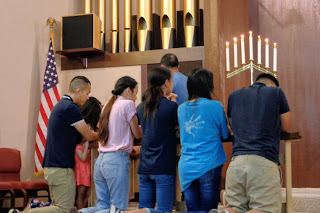Kaying Lee, whose husband is pastor of the Hmong ministry at Peace Lutheran Church, told us she sometimes hears this question from people in the Hmong community. She explained to us that Christianity is new to Hmong people, and many see it as a Western religion -- until they get to know it better.
The Lees have served at Peace Lutheran in Fresno since 2008. Many of the younger Hmong of the church attend the morning English language service, but some are more comfortable attending the Hmong language service at noon.
Janett Lee, Pastor Khai and Kaying’s daughter, led the class (we didn’t know they were related until after class). Janett started working with the Hmong youth when her parents started at the church, but a few years ago the English language congregation of Peace was without a youth pastor, so they combined the two youth groups, with Janett becoming the official youth leader in 2013.
The classroom was a bit messy that morning, since there had been a wedding the day before and the Sunday School room was the changing room for the bridal party. During the week, the room had been used for the church’s Vacation Bible School.
The high school lesson was on Easter morning’s empty tomb, looking at the various Gospel tellings of the Resurrection story. Students continued to come in throughout the hour until there were eighteen kids in the room. Janett used Scripture for the lesson but also used Luther’s Small Catechism with Explanation. (Kaying mentioned that one of the good things the Lutheran Church offered the Hmong people was the Catechism with its clear presentation of Scripture and theology.)
We weren’t the only bonus adults in class that morning. David, an elder in the church, sat in to observe for a bit. I tried not to talk too much, but the youth pastor in me couldn’t refrain from adding a comment or two.
I talked with Janett after class about her work with the youth. She said that at times they’ve had some troubled kids. She described a kid from several years back who was a bit of a gangbanger, until he decided he prefered what the church had to offer. Their ministry emphasizes service, looking for ways to reach out to the community. If they do a beach trip, they’ll spend an hour picking up litter.
While I talked to Janett, a number of the kids were putting on choir robes. We learned that the youth provide the music for the Hmong worship service.
We went to the sanctuary for the worship service, and Kaying invited us to sit with her in the front row so she could explain what was happening in the service. Much of the music was familiar (“Amazing Grace,” “Jesus Saves”), but the words were Hmong. The youth choir also sang some songs in English during the service.
The Scripture readings were in Hmong, but the Hmong spelling of the names of Biblical books are close enough figure out. (Besides, Kaying told us as well.) It’s interesting to hear the Lord’s Prayer and the Apostle’s Creed in a different language, because the cadences and rhythms are familiar even when the words aren’t.
Janett gave a children’s message in English, the youth sitting with the little kids -- who were brought in from their class for the story -- in the front.
Pastor Khai’s sermon on Psalm 91 was in Hmong, but on occasion there were phrases and whole sentences in English. I asked him after the service whether he did that for our benefit, and he assured us he hadn’t. He said that some things are just easier to say in English than in Hmong, which makes sense. Hmong Christians haven't had many years to come up with words for Biblical, spiritual, and theological concepts that the church has been trying to put in words for millennia.
Kaying went forward with us for communion, which I appreciated because even though a Lutheran communion is pretty much a Lutheran communion (open hands to receive communion, closed hands for a blessing), I was concerned I’d miss an instruction in Hmong and do something embarrassing (maybe not like pouring the wine down my front, but who knows?).
In the closing announcements I heard the words “silent auction” and “egg rolls;” then Janett announced that the church had a fireworks booth in the SaveMart parking lot to raise money for youth projects. (I’m pretty sure the fireworks announcement was in English, unless I really caught on to Hmong this month.) I know where we’ll be getting our sparklers.
Everyone was quite gracious and welcoming; Kaying let us know we’d be welcome at any time and invited us to a wedding later this summer. It was good to worship the Hmong God with folks at Peace Lutheran. (Who happens to be one and the same with the American God. And the Kenyan God. And the Australian God. The One God.)
Statistics:
Sermon Length: 24 minutes
Visitor Treatment: We were greeted numerous times before and during the worship service. The church had a guest book outside the sanctuary, which we signed (we also filled out a communion card)
Followup by Tuesday Morning: none
Our Rough Count: 58 (including the little kids who came for the children's message
Probable Ushers’ Count: 65
Snacks: in the Sunday School class, there were trays of crackers and cheese, fruit, veggies, and bagels with cream cheese, along with water pitchers
Musicians: keyboard (woman)
Vocals (choir) 6 women, 4 men
Distance to Church: 1 mile
Open WiFi: no
Tie/Suit Count: none
Church Website: peacelutheranfresno.org/hmongministry
















































